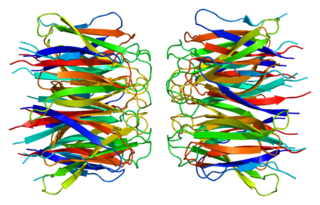
Robert G. Roeder is an American biochemist. He is known as a pioneer scientist in eukaryotic transcription. He discovered three distinct nuclear RNA polymerases in 1969 and characterized many proteins involved in the regulation of transcription, including basic transcription factors and the first mammalian gene-specific activator over five decades of research. He is the recipient of the Gairdner Foundation International Award in 2000, the Albert Lasker Award for Basic Medical Research in 2003, and the Kyoto Prize in 2021. He currently serves as Arnold and Mabel Beckman Professor and Head of the Laboratory of Biochemical and Molecular Biology at The Rockefeller University.
In eukaryote cells, RNA polymerase III is a protein that transcribes DNA to synthesize 5S ribosomal RNA, tRNA, and other small RNAs.

The 5S ribosomal RNA is an approximately 120 nucleotide-long ribosomal RNA molecule with a mass of 40 kDa. It is a structural and functional component of the large subunit of the ribosome in all domains of life, with the exception of mitochondrial ribosomes of fungi and animals. The designation 5S refers to the molecule's sedimentation coefficient in an ultracentrifuge, which is measured in Svedberg units (S).

Nucleophosmin (NPM), also known as nucleolar phosphoprotein B23 or numatrin, is a protein that in humans is encoded by the NPM1 gene.

High-mobility group protein HMG-I/HMG-Y is a protein that in humans is encoded by the HMGA1 gene.

POU domain, class 2, transcription factor 1 is a protein that in humans is encoded by the POU2F1 gene.

Nuclear respiratory factor 1, also known as Nrf1, Nrf-1, NRF1 and NRF-1, encodes a protein that homodimerizes and functions as a transcription factor which activates the expression of some key metabolic genes regulating cellular growth and nuclear genes required for respiration, heme biosynthesis, and mitochondrial DNA transcription and replication. The protein has also been associated with the regulation of neurite outgrowth. Alternate transcriptional splice variants, which encode the same protein, have been characterized. Additional variants encoding different protein isoforms have been described but they have not been fully characterized. Confusion has occurred in bibliographic databases due to the shared symbol of NRF1 for this gene and for "nuclear factor -like 1" which has an official symbol of NFE2L1.

Nuclear transcription factor Y subunit beta is a protein that in humans is encoded by the NFYB gene.

Elongation factor 1-alpha 1 (eEF1a1) is a translation elongation protein, expressed across eukaryotes. In humans, it is encoded by the EEF1A1 gene.

Insulin-like growth factor-binding protein 1 (IBP-1) also known as placental protein 12 (PP12) is a protein that in humans is encoded by the IGFBP1 gene.

Probable ATP-dependent RNA helicase DDX5 also known as DEAD box protein 5 or RNA helicase p68 is an enzyme that in humans is encoded by the DDX5 gene.

Transcription elongation factor A protein 1 is a protein that in humans is encoded by the TCEA1 gene.

Insulin-like growth factor 2 mRNA-binding protein 1 is a protein that in humans is encoded by the IGF2BP1 gene.

Alpha-globin transcription factor CP2 is a protein that in humans is encoded by the TFCP2 gene.

Transcription factor IIIB 90 kDa subunit is a protein that in humans is encoded by the BRF1 gene.

General transcription factor 3C polypeptide 2 is a protein that in humans is encoded by the GTF3C2 gene.

General transcription factor 3C polypeptide 1 is a protein that in humans is encoded by the GTF3C1 gene.

Transcription factor 7 is the gene that in humans encodes for the TCF1 protein.

General transcription factor IIF subunit 1 is a protein that in humans is encoded by the GTF2F1 gene.

General transcription factor IIF subunit 2 is a protein that in humans is encoded by the GTF2F2 gene.






















